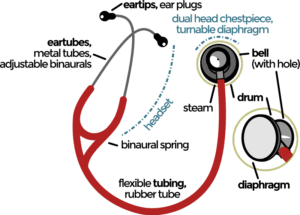Parts of the stethoscope
It was initially invented by René Laennec back in 1816, in Paris, France.
Back then, stethoscopes were simple funnel-looking contraptions
Today, the stethoscope is an essential tool for healthcare professionals.
The stethoscope consists of several parts that work together to amplify and transmit sounds from the body and allow us to hear them.
In this article, we discuss the different parts of the stethoscope.
1) Chestpiece
The first part of the stethoscope is the chest-piece, which includes the diaphragm and the bell.
The diaphragm is the larger flat side of the head. Additionally, the diaphgram is for high-frequency sounds, such as heart and lung sounds.
The bell is the small, circular opening on the opposite side of the head. It is for listening to low-frequency sounds. This is especially useful when you want to identify whether a murmur is radiating to the carotid, as part of the carotid assessment. However, the bell can also be used for pediatric or thin patients. You can maneuver between each one by twisting it 180 degrees until it clicks.
Alternatively, if the diaphgram was pressed firmly against the skin, that can also be used to listen to high-frequency sounds and if it were to be pressed softly, lower-frequency sounds. That is why master-type stethoscopes only have 1 side. However, if you happen to have a turnable chestpiece that has a diaphgram and bell, please use them according to their intended purposes, especially under exam conditions.
2) tubing
The tubing of the stethoscope connects the chestpiece to the earpieces. Additionally, the tubing, made of rubber or plastic, is responsible for transmitting the sounds from the head to the earpieces. Some stethoscopes have double tubing, which separates the sounds and allows the user to hear them more clearly.
3) Earpieces
Earpieces amplify the sounds heard from the chestpiece. Silicon earpieces allow a better fit. Having a well-fitted earpiece can help block out background noise and hear the sound (auscultate) better. Usually, some stethoscopes come with alternative-sized earpieces so that it fits appropriately.
4)Binaurals
Binaurals are the metal pieces that connect the earpieces to the tubing. Binaurals come in various angles and lengths to suit different head sizes and preferences. Some stethoscopes have adjustable binaurals to adjust the angle for a more comfortable fit by compressing or widening the binaural spring.
Conclusion
In conclusion, the stethoscope is a complex device that consists of several parts that work together to amplify and transmit sounds from the body. Understanding the different parts of the stethoscope and how they function is essential for healthcare professionals who use this device on a daily basis.
To learn ways how to stop losing your stethoscope, please check out one of our posts:
Top 5 stethoscope accessories to prevent losing your stethoscope

